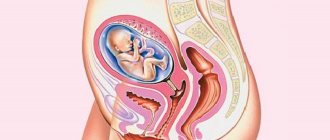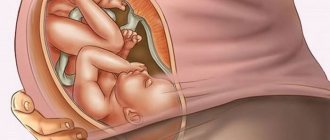Having felt pregnant for the first time, a woman wants the period of bearing a child to go as best as possible. Therefore, she tries to pay attention to any changes in her condition. And, noticing even small deviations, he begins to worry and tries to find out what the reason is. A similar thing is observed in cases where a woman discovers that her stomach has become smaller than it was before. Why this happens and what should be done are questions to ask your doctor. He is the one who has the greatest competence to solve the problem.
Norm
From the 12th week of gestation, a woman visits an antenatal clinic and a family doctor to monitor the progress of pregnancy. Medical examination includes laboratory and instrumental methods and clinical and gynecological examination. During the latter, abdominal circumference is measured - a mandatory anthropometric indicator for pregnant women. Normally, it should constantly increase, because the child in the womb also grows. The average is approximately 1 cm per week. But individual fluctuations are possible due to the constitutional characteristics of the woman herself (the thickness of the subcutaneous tissue) and her diet during pregnancy.
It should be noted that the uterus begins to grow noticeably only after the 18th week, and before that it is located behind the pubic symphysis and is inaccessible for measurement. And those girls who see an enlarged tummy already in the first trimester should be told that these are just gases in the intestines. The measurement is taken with a measuring tape at the level of the navel. And based on gestational age, abdominal circumference changes as follows:
- Week 20: 70–75 cm.
- Week 22: 72–78 cm.
- Week 24: 75–80 cm.
- Week 26: 77–82 cm.
- Week 28: 80–85 cm.
- Week 30: 82–87 cm.
- Week 32: 85–90 cm.
- Week 34: 87–92 cm.
- Week 36: 90–95 cm.
- Week 38: 92–98 cm.
- Week 40: 95–100 cm.
During the examination, the doctor measures another important indicator - the height of the uterine fundus. Together with the abdominal circumference, it allows you to calculate the probable weight of the fetus (with an error of 150–200 g). But all calculations should be allowed to be performed by a specialist, because when measuring independently, you may not take something into account and make an error.
During a normal pregnancy, the abdominal circumference should increase with the growth of the uterus and the baby in it.
Causes
A small belly during pregnancy can make a woman quite nervous. After all, the main thing is that the child develops normally and does not need any help. And often her worries are in vain, because the apparent reduction in the tummy can be associated with simple factors:
- The release of gases from the intestines in the early stages.
- Change in fetal position.
- Measurement error.
This does not affect the unborn child in any way, so it should not be a cause for concern. When determining the source of a small belly, you must also take into account what diet the woman followed during the past period, because she could have lost weight, which means that the thickness of her own subcutaneous tissue has also decreased. But this condition is not entirely physiological, because the child needs nutrients, but he cannot get them except from the expectant mother. For this, a woman needs to eat well.
But there are also more pessimistic options for the development of events. Since abdominal circumference reflects the morphological characteristics of the fetus and the volume of the intrauterine space, you should seriously think about the possibility of obstetric pathology:
- Low water.
- Fetal hypotrophy.
- Frozen pregnancy.
And if a woman’s belly is smaller than expected for the duration of pregnancy, then these conditions should first of all be excluded. In turn, they are the result of another pathology, for example, late gestosis, fetoplacental insufficiency, intrauterine infections, diseases of the expectant mother (diabetes mellitus, hypertension). This poses a risk to the baby and can lead to other complications.
Reducing the size of the abdomen is a common cause for concern during pregnancy. This phenomenon may have a physiological basis, but it can also be a consequence of obstetric pathology.
Chills during pregnancy
Experienced women begin to be tormented by doubts about whether they are pregnant after a missed period. If a woman consciously wants to conceive a child, selects favorable days for this, then within a day or two after possible conception she wants to know: did it work out? And this impatience of the expectant mother is quite understandable. After all, there is still a long wait for the final verdict - until the delay and purchase of a pregnancy test. What can serve as a signal that conception has taken place?
Chills in early pregnancy
Every woman reacts differently to pregnancy. More precisely, the reaction of each organism is individual. Some women do not experience anything at all; they do not have toxicosis in the early stages. Others immediately fall into a state of anxiety, anticipating pregnancy symptoms. And sometimes the waiting period turns a woman simply into a neurasthenic.
Still other women, 6-7 days after conception, feel unwell and weak, have a fever or chills. This situation worries the woman a little, because while expecting pregnancy, she begins to assume that she has caught a cold. So what should she do next? Take antipyretic and anti-cold medications? It is too early to worry in such a situation, because the above symptoms may just mean pregnancy.
How are these symptoms related to successful conception? The optimal temperature for the existence of the fertilized egg is 37 degrees. For this reason, before ovulation, the basal temperature of a healthy woman always rises. The hormone progesterone is responsible for this increase. If conception has occurred and pregnancy has occurred, then the amount of progesterone in the blood increases instead of its traditional decrease during menstruation. Accordingly, in some women the body responds to this phenomenon not only by increasing basal temperature
Consultations, recommendations, stories
Symptoms
As a rule, any pathological changes in the body of a pregnant woman have their own manifestations. And all the symptoms that were not there before require detail. During the examination, the doctor compares the measured indicators with the norm for a certain gestational age and makes an assumption about the possible origin of the deviations. Thus, a decrease in abdominal circumference by 1–2 cm compared to the results of the previous examination should alert you and become a reason for additional research.
Low water
If there is little amniotic fluid, then the volume of the intrauterine space decreases. Normally, by the end of pregnancy their amount reaches 1–1.5 liters. Moderate deviations (within 400–600 ml) are visible only on ultrasound, but do not manifest themselves clinically. And when oligohydramnios reaches significant severity (reduction by a third or half), it already becomes noticeable. The following symptoms appear:
- The size of the abdomen does not correspond to the gestational age.
- When the fetus moves, discomfort appears.
- Periodically ache in the lower abdomen.
- The general condition worsens: dry mouth, nausea, weakness.
The smaller the volume of amniotic fluid, the more difficult it is for the fetus to move in the uterine cavity. As a result, physical development suffers and various anomalies of the osteoarticular system can be observed: clubfoot, torticollis, spinal curvature. There is a high probability of compression of the umbilical cord, which means intrauterine hypoxia and even death. In addition, pregnancy with oligohydramnios often ends in premature birth.
Fetal hypotrophy
During the next examination, it may be revealed that the abdominal circumference is smaller than it was a month ago. Then it’s worth thinking about fetal malnutrition. Delayed physical development, identified clinically, requires further verification by instrumental methods (fetometry), which provide more accurate information about the child’s condition. Then, based on the anthropometric indicators of the fetus, several degrees of pathology can be distinguished:
- 1 – delay by 1–2 weeks.
- 2 – delay of up to a month.
- 3 – delay of more than a month.
A child born on time with malnutrition will be smaller in weight and height, but cannot be called premature. Deviations in physical parameters are normalized during the first six months of life or even earlier - subject to adequate nutrition and care.
A small belly may be a sign of fetal malnutrition or intrauterine growth retardation, when the physical parameters of the fetus do not correspond to the gestational age.
Frozen pregnancy
The most serious situation occurs when the pregnancy stalls. To put it simply, intrauterine fetal death occurs. The following signs indicate this:
- The size of the uterus becomes smaller than expected.
- Nagging pain appears in the lower abdomen.
- Bloody discharge begins.
- Fetal movements disappear.
- Toxicosis stops.
- Breasts stop growing.
- The temperature rises.
- There is general weakness and trembling in the body.
A frozen pregnancy ends in spontaneous abortion or is complicated by infection (endometritis), bleeding and disseminated intravascular coagulation syndrome. This threatens not only the woman’s health, but also her life. Therefore, obstetric pathology should be suspected as early as possible and its consequences eliminated in a timely manner.
Additional diagnostics
Additional research will help to understand why the belly has shrunk. A diagnosis can be made based on the clinical picture, but then it will be incomplete. And the doctor’s final conclusion is based on a full examination, which necessarily includes an ultrasound, when the size of the fetus is analyzed (fetometry), its weight is calculated, the amniotic fluid index is measured, determining the correspondence of these indicators to the gestational age.
In some cases, other instrumental and laboratory tests may be required - if the expectant mother is suspected of having gynecological or general diseases. The list of methods used will correspond to the type of pathology.
Thus, a small belly is a sign that you must pay close attention to. And even if everything is within the physiological norm, it won’t hurt to consult a doctor once again. The specialist will reassure the woman or confirm any abnormalities that require medical intervention. And in the latter case, it is difficult to overestimate the importance of timely diagnosis.
What is the difference between a woman who is expecting a child and just a woman? Most will immediately answer that it is the size of the belly. But there are those who will object to them, and they will be right. Why do some women have huge bellies, while others have barely noticeable bellies? Although most expectant mothers do not pay much attention to the size of their belly, there is an opinion that it is more important to monitor and control swelling, pressure, stretch marks, etc. Each belly is individual and grows according to a schedule. But it is very important that there are no deviations from generally accepted norms. There may or may not be an explanation for a small belly. Maybe this is a pathology of fetal development, or maybe this is just your norm, and at the same time a completely healthy child will be born.
In the first trimester of pregnancy, there may or may not be a belly; if a woman suffers from toxicosis, then the belly will disappear and begin to grow only in the second trimester. Everyone probably has a couple of girlfriends whose belly was small throughout their pregnancy and not everyone even knew that the woman was about to give birth.
In any case, there is no need to panic right away; you must first undergo all examinations and tests.
Let's look at why the belly grows?
Nevertheless, in the overwhelming majority of cases, the belly grows and this is explained by the fact that the uterus is growing, in which the child develops and grows. During pregnancy, the uterus must contain the fetus, placenta and amniotic fluid, all this must fit somewhere, in addition, the child must be comfortable and safe inside the woman, which is why the uterus grows, changes its shape and location in the abdomen.
The uterus changes from the very early stages of pregnancy, firstly, it changes its shape from triangular to round, and secondly, it grows, and very quickly, although this will not be noticeable until a certain time, the fetus grows, amniotic fluid fills the uterus, surrounding fetus. All changes will not be noticeable until about the 5th month, from which time the belly begins to grow. In the fifth month, the weight of the fetus is approximately 100 grams, its length is 12 cm. By childbirth, these indicators will increase tens of times and the child can be born with a body weight of 2.5 to 5 kg, height 42-60 cm. All indicators will be formed at 35-36 -th week of pregnancy.
At each visit to the doctor, the doctor will measure the abdomen with a measuring tape; from these figures, you can approximately determine the gestational age and the weight of the fetus. Also, during the entire pregnancy, amniotic fluid constantly changes its volume, it can be from 1000 to 15,000 ml, but if the pregnancy is post-term, then the volume of amniotic fluid can be reduced to 800 ml.
Let's consider norms and deviations
Although all women are completely individual, there are some norms that are approximately the same for all pregnancies, and deviations from them signal pregnancy problems.
Let's take a look at the description of the uterus throughout the entire duration of pregnancy.
At the 4th week, the uterus looks like a chicken egg, at the eighth week it already looks like a goose egg, increasing in size. At the 12th week, the uterus is the size of a newborn’s head; at the appointment, the doctor palpates it through the anterior wall of the abdomen and measures the circumference of the abdomen. At the 16th week you can already notice a rounded tummy; if you imagine the place between the pubis and the navel, then the uterus is now located somewhere in the middle. At the 20th week, the belly is already clearly visible to others, this is exactly the middle of pregnancy. The fundus of the uterus is located two fingers below the navel. At the 24th week, the fundus of the uterus moved to the level of the navel, and at the 28th week the uterus is already located above the navel. At the 32nd week, the navel is leveled, the baby is growing and the fundus of the uterus can be felt somewhere between the navel and the xiphoid process. At the 38th week, the uterus rises to its highest level to the costal arches. At the 40th week, the navel is already protruding, and the fundus of the uterus drops again, preparing for childbirth.
During the entire pregnancy, the uterus grows approximately 20 times. The muscle fibers of the uterus also change. Thickening and increasing in length 10 times. The vascular network of the uterus also increases. Abdominal circumference is a very important parameter during pregnancy; it is measured in the area of the lumbar deflection in the back and the navel in front. The norm is 85-90 cm at the 32nd week, 90-95 cm at the 36th week, and 95-100 cm at the 40th week.
If there are nevertheless deviations from general norms, then the reasons may be the lack of fetal growth, this is the so-called malnutrition (fetal growth retardation), or oligohydramnios. The reasons for this are infectious and inflammatory diseases of the expectant mother, placental insufficiency, and hypertension in a pregnant woman. Often the cause may be improper placement of the fetus in the uterus, in which case a caesarean section is necessary. The uterus grows almost from the very first days of pregnancy; if the doctor notices that this is not happening, then an ectopic pregnancy can be diagnosed. This is a pregnancy pathology in which the fertilized egg develops outside the uterus, but in its tube, for example.
Also, do not forget that each woman has her own constitution, one will have a belly before pregnancy, another will not have one even during pregnancy. It happens that at a pregnant woman’s work, no one even suspects that their colleague is pregnant until the woman goes on maternity leave.
In case of any suspicions or deviations from the norm, the expectant mother should always consult a doctor; only he can make the correct diagnosis and try to save the pregnancy even with all its possible problems. If there are any problems, then you need to go to the hospital and be treated, the likelihood of recovery and the birth of a healthy child is very high. Do not delay registration and passing all necessary tests. Ideally, all your illnesses should be cured before pregnancy; any harmless infection or bacteria can cause complications during pregnancy. It is necessary to eat properly before conception and during pregnancy, lead a healthy lifestyle, it is advisable to give up all your bad habits, from smoking and alcohol to eating chocolate at night.
And of course, a woman should listen very carefully to her body, which almost always signals any problems. You also need to have a positive attitude and believe that everything will definitely be fine and you will have a healthy baby!
Author of the publication: Eduard Belousov
If the belly grows slowly during pregnancy, the woman begins to worry. It seems to her that the future baby will be born with disabilities. You can dispel fears if you know what norms exist and what alarming symptoms can indicate the onset of pathology.
Traveling by car during pregnancy
If pregnancy is not a disease, then there is no reason to deny yourself the pleasure of traveling by car? Or should you still be careful? We will answer the main questions that concern expectant mothers.
Is it possible to drive a car while pregnant?
Definitely YES. But only drive, and not wash, repair, change or inflate a flat tire. Refueling only from an automatic dispenser, without using cans, is physically difficult and dangerous due to inhalation of toxic fumes when sucking fuel into your mouth through a hose.
It is better to avoid driving in the city if you have little experience, are overly emotional, or become absent-minded. And so that your skills are not forgotten, and for the sake of pleasure, you and your husband can go out into nature along quiet country roads.
What to prefer for regular trips: public transport or a personal car?
If you feel like a fish out of water in the hustle and bustle of city traffic, keep driving. This way there is less shaking due to frequent stops, crowding during rush hours in the cabin and the risk of contracting a viral infection.
If the seat belt presses on your stomach, can you not wear it?
It is imperative to protect yourself and your baby! For convenience, special locks have been invented that secure a regular seat belt under the tummy. It is enough to purchase such a seat cushion once with an additional fastening for a seat belt, and you can forget about the problem of a belt pressing on your stomach in all subsequent pregnancies.
What to do if you get motion sickness during a trip?
If similar symptoms were observed before pregnancy, you will have to forget about medications against seasickness - they are contraindicated at any time. We advise you to remove all fragrances from the cabin, eat little by little on the road, suck on mint candies or keep a slice of lemon in your mouth. Traditional methods help: sit straight in the front seat, don’t read, look at the road and tilt and turn your head less.
If motion sickness appears after conception, the cause may be nausea in the first trimester of pregnancy. Her recommendations are the same. The main thing is not to starve, and if you vomit, drink small sips of still mineral water.
In the second half of pregnancy, if symptoms of motion sickness appear, you need to stop to rest and straighten up. And be sure to measure your blood pressure: if it has increased, go to the nearest medical facility. It is dangerous to travel further without being examined by a doctor, because nausea can be a symptom of gestosis.
Remember: you cannot drive the car yourself while experiencing an attack of nausea. This greatly increases the risk of getting into an emergency.
Until what stage of pregnancy can you travel long distances?
It all depends on the chosen route, the urgency of the trip and the comfort of the car. The longer the pregnancy, the softer the suspension should be, the more time is needed for frequent stops to rest. And the main thing is that between settlements where they can really provide competent medical care, there should be no more than 3 hours of travel. Then there are no restrictions.
Is shaking while driving a car really dangerous?
Dangerous! Imagine a 3-liter jar, 2/3 filled with water, closed with a nylon lid and turned upside down. Can you confidently say that the lid will not open if you shake it sharply? When the car bounces over potholes or speed bumps, amniotic fluid hitting the cervix (lid) can stimulate it to open. Especially if there is a threat of miscarriage, or when the cervix softens after 32 weeks in preparation for childbirth.
But that's not all. In a sitting position, especially for a long time, the uterus is compressed by the femur and pelvic bones. Therefore, even a small sharp push is enough for the membranes holding the amniotic fluid to rupture. Especially if there is inflammation (colpitis), making the membranes loose and weak.
What to take with you on a long journey?
- all medical documents, insurance policy, notebook with telephone numbers of an obstetrician, close friends and relatives;
- a pillow under the back;
- special seat belt for pregnant women;
- soft, loose slippers (feet may swell);
- a first aid kit with a supply of medications that you take regularly. Put activated charcoal, Maalox or another anti-heartburn remedy, Regidron in it. In hot weather, a pack of cooling medical gel will not hurt;
- tonometer for measuring blood pressure;
- drinking and mineral water without gas;
- stock of products that save you from nausea. This is individual: crackers, candy, lemon, nuts, dried fish - anything but non-perishable;
- bags in case of vomiting.
How to make a long trip comfortable and safe for an expectant mother?
Stop as often as possible to rest and empty your bladder. Remember: you cannot tolerate it, so as not to cause an increase in the tone of the uterus or the appearance of contractions. Walk during stops to reduce blood stagnation in the veins of the legs. Do not wear constrictive clothing, except maternity tights for varicose veins.
Sit in the car so that the least pressure is felt on the uterus, and the legs (if possible) are higher than the pelvis. The front passenger seat is best for this. It should be pushed back as much as possible, the back should be tilted back a little. Your legs apart and slightly bent at the knees can be periodically placed on the front panel (if you are sitting in the back, it is good to place your legs on the backrest of the front chair folded forward).
Be sure to buckle up!
In hot weather, use air conditioning rather than opening all windows for through ventilation. In cold weather, make sure that your feet are warm, but do not turn on the heated seat for a long time.
Don’t take travel companions: this way mommy is freer and there’s less risk of catching an infection.
Make sure your mobile phone battery is charged.
If a pregnant woman decides to travel alone, describe the route in detail to close people and call often. But after 28 weeks, it is better not to take risks and plan a trip with an accompanying person.
Make sure that the car first aid kit is complete and that the medications included in it have expiration dates.
In what situations are long trips contraindicated for pregnant women?
This list is suitable for both passengers and drivers:
- gestosis of any severity (swelling, increased blood pressure, rapid large gain in body weight);
- threat of miscarriage or premature birth - at any time;
- poor health – attacks of severe nausea, repeated vomiting, tendency to faint, general weakness, drowsiness, cramps in the calf muscles and toes;
- placenta previa, spotting that occurred previously at any stage of pregnancy, isthmic-cervical insufficiency (remember the overturned jar!);
- rapidly progressing varicose veins of the legs and genitals, severe dilatation of hemorrhoidal veins, deep vein thrombosis and thrombophlebitis in the past;
- after 34 weeks - multiple pregnancy, pelvic or abnormal position of the fetus, any features of the condition of the woman and her child, in which delivery by cesarean section is planned.
The main rule in any stage of pregnancy is to discuss with your obstetrician-gynecologist the possibility of frequent travel or long travel by car. If there is the slightest doubt about their safety for the mother or her unborn baby, refuse. In the end, the 9-month wait will pay off with a sea of happiness after the birth of a healthy baby.
Category: Advice for pregnant women Topics: car, pregnancy, travel Link to material: Traveling by car during pregnancy
Norms for abdominal size during pregnancy
Norms for uterine fundus height and abdominal circumference
The waist begins to blur as the fetus grows. In the third week from the moment of conception, the size of the embryo is 3 mm. His condition cannot in any way affect the change in his figure.
Around the end of the second month, the placenta is already fully formed, and the fetus begins to develop organs of all systems. The head is still tilted towards the chest, but barely visible fingers are already appearing on the limbs. The outlines of the ears, nose and eyes are clearly visible. The body length is only two and a half centimeters, the embryo turns into a fetus, it occupies all the free space in the uterine cavity. Its weight is 25 grams. Externally, the existing changes are not yet visible.
By the fifteenth week, the fetus increases in size by about five times. He acquires a swallowing and sucking reflex, eyelashes and eyebrows appear, his kidneys and bladder are already working. The eyes become sensitive to light. The baby's height reaches 20 cm. On an ultrasound, you can see his gender. The uterus corresponds to the parameters of a goose egg, so in some women the stomach is noticeably rounded, everyone notices the changes. From this point on, the gynecologist begins to determine the circumference and record the data in a table.
At 21 weeks of pregnancy, active growth of the fetus occurs. It already weighs 400 grams. Development parameters are rapidly progressing. At week 28, the fundus of the uterus is at the level of three fingers above the umbilical cavity. At week 38 it reaches its maximum threshold - the costal arches.
An increase in waist size depends not only on the development of the unborn child. This indicator is affected by an increase in the amount of amniotic fluid. In the third month there is only 50 ml, by the end of the third trimester there is already more than a liter.
Causes of a small belly
In thin girls, the belly becomes noticeable earlier than in fat girls.
In nulliparous girls, the first visible changes in the figure appear when fetal movement is clearly felt (at about the seventeenth week). For mothers expecting their second child, this happens three weeks earlier. In the first case, the muscular frame of the peritoneum has a higher tone; it is still able to resist the processes occurring inside the body, so the woman manages to hide her interesting position for a long time.
During the second pregnancy, the belly grows faster. The muscles that support it become more extensible. The order of gestation is the next factor that can explain why different women have different waist sizes at the same stage.
It is necessary to take into account the individual characteristics of the physique. In obese women, pregnancy is less noticeable than in thin women of short stature.
Genetic predisposition plays a big role in the issue at hand. The girl will develop a belly at approximately the same time as her mother.
Fetal presentation can also explain why some pregnant women have a small belly, while others have a large one. In women with anterior presentation, the described parameter is more pronounced. With a transverse position of the fetus, the interesting position will not be noticeable even at the beginning of the third trimester. Then the baby is able to roll over, and then the figure will change greatly.
Severe toxicosis in the early stages is another reason for unnoticed pregnancy. It is very exhausting, girls lose significant weight. Poor nutrition in this condition leads to the fact that all useful microelements are taken by the fetus. Mom's body is depleted. Because of this, she becomes very miniature.
A rounded belly also appears late in those who are actively involved in sports.
All of the above indicators are purely individual. There is no need to worry in advance and compare yourself with others. The main task of the expectant mother is to focus on her body and closely monitor changes in condition.
Alarming symptoms
Only a gynecologist can identify characteristic signs of a lag in abdominal enlargement during an examination and routine measurements of circumference. If data comparison reveals a lack of progress, there is cause for concern. This phenomenon may indicate various pathological conditions:
- Oligohydramnios is a decrease in the volume of amniotic fluid. Diagnosed at any stage of embryogenesis using ultrasound. Associated with increased perinatal mortality. The pathology is asymptomatic, only some women note the appearance of discomfort during fetal movement. In the absence of the required amount of amniotic fluid, intrauterine growth retardation occurs. There are three degrees of severity. Determining the type of disease allows you to determine the feasibility of continuing pregnancy. Ignoring the problem leads to the birth of children with underdeveloped lungs, with bent legs, a narrow chest, and atresia of the digestive tract.
- Fetal hypotrophy is a pathology in which the baby’s development occurs with a lag in parameters corresponding to the norms of a given period of pregnancy. If the disease occurs in the first trimester, a symmetrical form is diagnosed. With it, the organs of the unborn child are uniformly reduced in size. This can happen for various reasons: chromosomal abnormality, intrauterine infection, developmental defects, maternal malnutrition, alcoholism, smoking. In the later stages, asymmetric malnutrition occurs. With it, the brain and skeleton develop according to the time course, and the kidneys and liver “freeze.” A woman cannot independently determine the diagnosis: the symptoms of the disease are vague. The condition is detected only with regular monitoring by an obstetrician-gynecologist and undergoing a routine ultrasound.
Timely identified pathological causes of abdominal shrinkage during pregnancy can be corrected. Treatment is carried out in a hospital, the treatment regimen is drawn up taking into account the gestational age.
If oligohydramnios is combined with fetal hypoxia, a decision is made to perform an emergency caesarean section. This is a necessary measure: the child in the womb experiences severe suffering.
In case of pathology not associated with underdeveloped kidneys in the fetus, the woman is recommended to drink plenty of fluids. It helps increase the amniotic fluid level by 30%.
Hypotrophy is treated comprehensively. The woman’s diet must be corrected and she is prescribed:
- vasodilators - improve placental blood flow;
- tocolytics - relax the uterus;
- medications that help eliminate oxygen deficiency.
If a girl carefully monitors her health and the pregnancy is progressing normally, a small belly is not a reason to worry. It doesn’t matter how the expectant mother looks from the outside, the main thing is that the development of her baby corresponds to the deadline.
If the belly is small during pregnancy, the expectant mother is overcome by anxiety. This may depend on the individual characteristics of the woman, but only the doctor determines whether there are any deviations from the norm.
Main causes of chills
If chills appear in a completely healthy woman, then it indicates hormonal changes that accompany any pregnancy and should not be a reason for panic. But you shouldn’t hide this unpleasant feeling from the gynecologist, since the doctor must be aware of all the processes occurring in his patient’s body.
Most often, chills make themselves felt a few weeks after conception and are observed throughout the first trimester. We can talk about the normal course of pregnancy when the discomfort disappears after two months and is not accompanied by an increase in body temperature.
A woman carrying a baby should closely monitor her health. It is recommended to visit a doctor if the following symptoms occur along with chills:
- Jumps in blood pressure, which may indicate fetal pathologies.
- Excessive urge to urinate and painful sensations in the abdomen. This is a sign that an inflammatory process is occurring in the patient’s bladder.
- An increase in temperature, indicating the penetration of an infection or virus into the body.
Trembling in the body, which is not associated with temperature or any disease, can be explained simply: during pregnancy, the body intensively produces progesterone, which irritates the hypothalamus. This phenomenon leads to chills, since in the absence of a fetus this hormone is produced in smaller quantities.
Appearance in early pregnancy
Women react to pregnancy differently. Exacerbations of chronic diseases, nausea and severe toxicosis or psychosis are often observed against the background of excitement in anticipation of the first child. It may also be that a few days after conception, a woman feels weakness, increased basal temperature and severe chills. This condition always worries a girl who expects signs of pregnancy, not a cold. But you should not worry, because it is precisely this reaction of the body that often indicates the presence of a fetus.
A woman’s body is designed in such a way that an embryonated egg can only develop at a temperature of at least 37 degrees Celsius, regardless of whether it is a boy or a girl. This explains the fact that at the beginning of ovulation, the temperature becomes higher and the production of progesterone increases. If conception occurs, the hormone level does not decrease, but only increases. Therefore, in the early stages, goosebumps are observed.
At 6 weeks of pregnancy
The first trimester of bearing a baby is considered the most dangerous and difficult period. At this time, the formation of the fetus begins (the gender of the child does not play a role in this), and its rapid growth occurs in the sixth week. During this period, there is a high risk of unauthorized termination of pregnancy, so the chills that appear should alert the expectant mother.
A woman should immediately see a gynecologist if the following unpleasant sensations occur: a feeling of rectal constriction, pain in the lower abdomen, vaginal discharge. If you consult a doctor in a timely manner and the sixth week goes well, the chances of saving and giving birth to a healthy child increase significantly.
Appearing at a later date
Goose bumps and a feeling of cold, which are observed in the later stages of pregnancy, cause the greatest concern. In this case, we are talking about frozen pregnancy - one of the most terrible pathologies.
A number of symptoms indicate this phenomenon:
- Disappearance of chest pain and toxicosis.
- Stop dizziness in the morning.
- Unreasonable rise in temperature.
A frozen pregnancy is manifested by the death of the fetus, which is not rejected by the body, but continues to be in the girl’s body. If such a situation arises, then the woman experiences intoxication from a decomposing corpse. When diagnosing a frozen fetus, the patient is given drugs that provoke uterine contractions and miscarriage.
Why is there a small belly during pregnancy?
A small belly is not a very common occurrence, but may well be a physiological norm. If the expectant mother has been examined and no pathologies in the development of the fetus have been identified, there is no cause for concern.
If you have a small belly during pregnancy, you need to consult a gynecologist
Gynecologist-obstetricians identify several natural reasons why a woman has a small belly during pregnancy:
- Heredity. If the parents are not tall and heavy, the future baby will most likely inherit a miniature physique.
- Toxicosis. In the first trimester of pregnancy, a woman loses weight due to bouts of toxicosis; in this case, the stomach loses weight in the same way as other parts of the body.
- Body features. In expectant mothers with a large figure and wide hips, the tummy is less noticeable than in petite girls.
- Condition of the abdominal muscles. A trained abs retains elasticity for a long time, keeping the stomach in good shape and preventing it from spreading out.
- Proper nutrition. If a young mother leads a healthy lifestyle and eats right, her belly remains small, because excess fat deposits do not accumulate in the waist area.
- Features of the location of the fetus. Sometimes the fertilized egg is fixed closer to the back wall of the uterus, and the baby inside is located across the pelvis. In such a situation, the tummy will not protrude much outward.
To make sure that your pregnancy is progressing normally, be sure to visit a gynecologist. Only he will be able to determine whether the size of the uterus corresponds to the term.
Vibration in the abdomen during pregnancy is there a danger?
If vibration in the lower abdomen during pregnancy is noted in the later stages, this may be due to such a feature as stretching of the fundus of the uterus and an increase in its pressure on the walls of the peritoneum. Do not also forget that the vena cava is located below. Supplying the placenta with all necessary elements and oxygen. When it is pinched, mommy may also feel discomfort.
In the early stages, vibration in the lower abdomen during pregnancy is observed less frequently than in the later stages. This is explained by the same growing belly, which puts pressure on all internal organs in the later weeks of pregnancy. Since such a factor is excluded in the early stages, there are few reasons why changes would be noted.
If during pregnancy a woman notices that vibration in the lower abdomen occurs after stress or a nervous breakdown, then most likely such negative consequences are the result of a nervous breakdown of the expectant mother. During the gestation period, the nervous system, like the supporting organs of women, works hard. Sometimes even the most harmless meaning or word means an unstable emotional state. After the experience, you can hear a pulsation in the lower abdomen.
Ringing in the stomach
A ringing sound in the stomach, which resembles periodic bouncing, similar to hiccups, may indicate that the child is developing as it should, and there is no reason to worry. As a rule, such changes are noted at 20-28 weeks of baby development. It is at this time that he develops rapidly, and his nervous system quickly begins to respond to changes.
It is also worth paying attention to the mother’s diet and lifestyle. If a woman does not receive the required amount of vitamins and microelements and leads a passive lifestyle, the placenta is not fully nourished. The lack of oxygen affects the supply of the placenta, and, naturally, the baby also suffers. If trembling is often observed in the lower abdomen, you should pay attention to the following features, if possible, eliminating risk factors:
- Eating fatty animal foods in large quantities. Butter, spreads, fatty varieties of pork or duck contribute to the accumulation of cholesterol in the blood. Its benefits are also undeniable for the child’s body, but its excess causes discomfort in the form of poor blood circulation through the veins, the walls of which become less elastic, unprepared for pressure changes. It is precisely with pressure changes that such manifestations as vibration in the abdomen are often associated. If a woman has a tendency to hypertonicity of the uterus and at the same time suffers from hypertension or hypotension, it is worth telling the doctor about this factor. You may need to prescribe vitamins or blood thinners, which are prescribed only after tests.
- Insufficient muscle activity leads to a lack of tissue nutrition. Many pregnant women, having learned about their situation, completely forget about the need for moderate physical activity. Lying on the sofa to rest after eating and falling asleep is a direct path to gaining extra pounds at the end of gestation. In addition, this lifestyle helps to relax the pelvic muscles, which will negatively affect labor. To avoid such an unpleasant moment, you should take care of walking before bedtime, walking exercises in the fresh air in any weather. Even a light rain is not a reason to deny yourself the pleasure of breathing fresh air. The duration of hours spent outside should not be less than 2 hours per day.
Ventilating the room does not fully compensate for the lack of oxygen.
- Nervousness and stress also contribute to the fact that a woman’s stomach begins to pull, and perhaps a nervous tic is felt in the lower abdomen. There is not necessarily a direct sequence between the experiences and the tic. The manifestation of twitching can be observed several days after suffering stress. As a rule, such negative changes are noted in the next 2-3 days.
Don't worry if it vibrates after a walk, warm-up, or physical exercise. This may be a manifestation of intense blood circulation, which is natural in this position.
Possible violations
Unfortunately, a small belly during pregnancy may also indicate disorders:
- Low water. If there is not enough amniotic fluid, the tummy practically does not grow, and the walls of the uterus put pressure on the baby, forcing him to be in an uncomfortable position. This condition is dangerous because it leads to curvature of the baby’s spine or legs, as well as to the accretion of its skin to the membrane of the fertilized egg.
- Fetal hypotrophy. A small belly in this case indicates a delay in the physical development of the fetus.
If such pathologies are detected, the expectant mother must undergo appropriate treatment and be constantly under medical supervision.
If a woman carefully monitors her health and the pregnancy is progressing normally, a small belly size is not a reason for concern. It doesn’t matter what the tummy looks like from the outside, the main thing is that the baby’s development corresponds to the stage of pregnancy.
What to do to reduce discomfort
If the state of vibration inside the uterus irritates or unnerves the mother, but no dangerous or pathological manifestations are noted either in the development of the baby or in its provision, some manipulations can be carried out. To prevent this condition, you should pay attention to your diet, walking and physical and breathing exercises.
Nutrition - recommendations
Since most problems in the development of pregnancy are caused by an incorrect, unbalanced diet, it is worth following the following recommendations at all stages of gestation:
- Eating in small portions.
- Do not drink water while eating food. That is, if you want to drink juice or water, then you should do it either before a meal or after, but not during, washing down the first or second courses.
- You can't combine proteins and carbohydrates. For example, it is better to eat meat with a side dish of vegetables or buckwheat, but not with potatoes or rice. Pasta should not be combined with meat or cheese, and during pregnancy grapes should generally be excluded or eaten in small quantities. In later stages, such a product contributes to the accumulation of gases in the intestines, as well as the gain of extra pounds for both mother and child.
- After eating, you don’t need to go to bed immediately, walk around the house, rest, watch TV, do breathing exercises, and only after 20-30 minutes you can rest. The digestive system also needs to prepare for sleep.
- You should not eat at night or after 8 pm. At such a time, the stomach is not able to digest food, and all reserves are put aside for later, which contributes to the incorrect functioning of the entire digestive system.
Recommendations for exercise and breathing
Proper breathing is the theorem of health and proper metabolism. In India, there is a whole hypothesis of a correct lifestyle, which includes the basics of correct breathing. Special exercises will help prepare for childbirth, supply the baby in the womb with the necessary amount of oxygen, and prepare the mother’s muscles for the passage of the baby’s head during childbirth.
Irregular, intermittent breathing or shortness of breath is also aggravated by the fact that the mother smoked before pregnancy. The lungs are contaminated with tar and nicotine, and therefore, with an even greater increased load, a feeling of weakness, clouding of reason, and nausea occurs. The basics of breathing are a task for specialists, but some exercises can be done at home by finding the necessary courses on the Internet.
What to do if the tone of the uterus is increased
With increased tone of the uterus, the child does not feel infringement, but may feel oxygen deficiency. With different forms and degrees of complexity, this degree of load on the mother’s body also increases. Vibration in the lower abdomen can be observed if the mother lies on her back, leans heavily on her spine, or sleeps in an uncomfortable position. It is also worth excluding curvature of the spine, since a lot also depends on such an organ, including the baby’s well-being.
In case of increased tone, medical control with regular monitoring of tests is recommended, as well as taking the medications that the doctor prescribes, based on the patient’s medical history and clinical picture. Some medications are recommended to be taken until delivery. There is also a risk of precipitate or premature labor.
source











